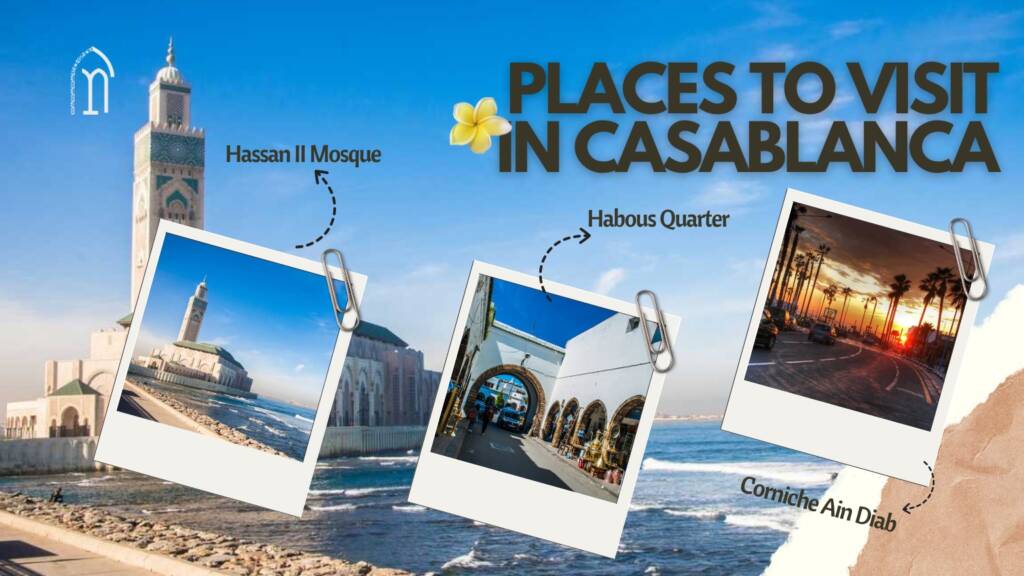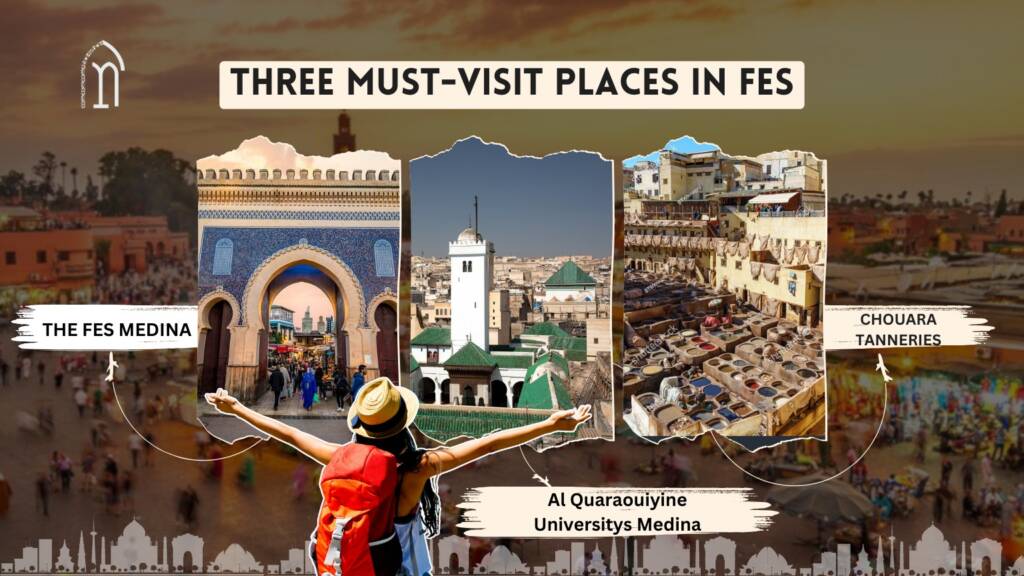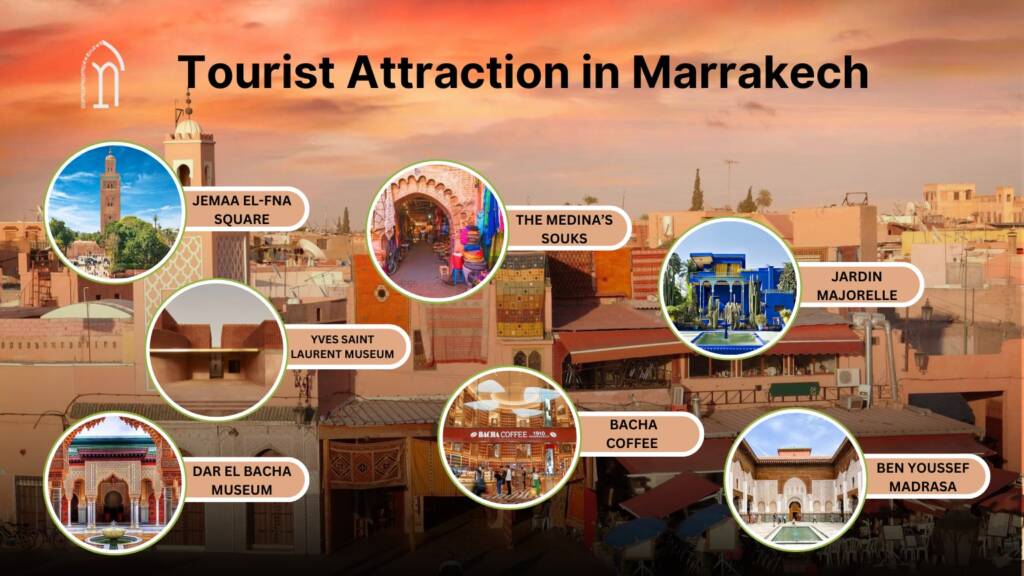Morocco Tourist Attractions
Here’s a detailed guide to the must-see cities in Morocco and what each destination has to offer. Each city is filled with hidden treasures, cultural riches, and stunning landscapes that will make your trip an unforgettable experience. Explore the beauty of these eye-catching and historical tourist attractions with friends and family.
1. Casablanca: The Gateway to Modern Morocco
Casablanca, often considered the economic capital of Morocco, is a cosmopolitan city that blends modernity with tradition. The city’s main attraction is undoubtedly the Hassan II Mosque, one of the largest mosques in the world, partly built on water and adorned with mosaics, marble, and carved wood. Visiting this mosque is a must for all travelers.

Beyond the mosque, Casablanca offers other interesting sites like the Habous Quarter, a modern medina built by the French in the 1930s, and the Corniche Ain Diab, a seaside boulevard perfect for an evening stroll. The city also boasts a vibrant art scene with galleries and exhibitions worth exploring.
2. Fes: The Spiritual Capital
Fes is the oldest of Morocco’s imperial cities and is often described as the cultural and spiritual heart of the country. The Fes Medina, also known as Fes el-Bali, is a fascinating labyrinth of narrow alleys, bustling souks, and historical monuments. This medina, a UNESCO World Heritage site, is one of the largest car-free urban areas in the world.

In Fes, be sure to visit Al Quaraouiyine University, the oldest university in the world still operating, and the Chouara Tanneries, where traditional leather tanning methods are still in use. The city is also famous for its craftsmanship, particularly pottery, leather goods, and zellige (ceramic mosaics).
3. Merzouga Desert: An Adventure in the Dunes
Merzouga, located at the edge of the Sahara Desert, is the perfect starting point for a full immersion into the vast desert. The Erg Chebbi dunes are among the highest in Morocco and provide a breathtaking backdrop for camel rides, 4×4 excursions, or even overnight stays in traditional Berber camps under the stars.
Watching the sunrise over the dunes is an experience not to be missed, as is stargazing in one of the most pristine areas free from light pollution. The Merzouga desert is also the ideal place to learn about nomadic culture and explore nearby villages like Khamlia, known for its Gnawa music.
4. Aït Ben Haddou and Skoura: Gems of the South
Aït Ben Haddou is a ksar (fortified village) located in the Ounila Valley, near Ouarzazate. This site, a UNESCO World Heritage site, is famous for its earthen kasbahs and narrow alleys, and it has served as a backdrop for many international films. Visiting this village offers a journey back in time to when caravans crossed the desert to reach Marrakech.
Nearby, Skoura is a lush oasis dotted with palm groves and historic kasbahs. The Kasbah Amridil is one of the most impressive and worth visiting for its well-preserved architecture. The Skoura region is also an excellent starting point for exploring the Atlas Mountains or for trekking in the Dadès Gorges.
5. Marrakech: The Red City and its Surroundings
Marrakech is perhaps the most iconic city in Morocco, attracting millions of visitors each year with its unique blend of culture, history, and modernity. The heart of the city is Jemaa el-Fna Square, a lively crossroads where storytellers, musicians, snake charmers, and street vendors converge. Around the square, the medina’s souks are filled with Moroccan crafts, textiles, jewelry, and pottery.
Other must-sees in Marrakech include Jardin Majorelle and the Yves Saint Laurent Museum, where you can explore the legacy of the famous French designer. For a cultural break, visit Dar El Bacha Museum, which houses exhibitions of contemporary Moroccan art, and enjoy a coffee at the renowned Bacha Coffee. Another must-see is Ben Youssef Madrasa, a beautifully restored former Quranic school known for its zellige tiles and carved wood ceilings.

Marrakech is also the perfect starting point for day trips to the Atlas Mountains, where you can visit traditional Berber villages, or to the Agafay Desert, a stony desert located just 30 km from the city, offering a Saharan experience without long distances.
6. Essaouira: The City of Winds
Essaouira, formerly known as Mogador, is a charming coastal town located about 2 hours from Marrakech. This port city, surrounded by ramparts, is famous for its laid-back atmosphere, wind-swept beaches, and UNESCO-listed medina. Wander through the medina’s narrow streets, visit the workshops of the artisans who craft thuya wood, and enjoy the many cafes and restaurants serving fresh seafood.
Essaouira is also known as the center of argan oil production, used in both cosmetics and cooking. Visitors can learn about the production process of this precious oil by visiting a local cooperative. For water sports enthusiasts, Essaouira is a popular spot for kite surfing and windsurfing.
7. Taghazout: Morocco’s Surfing Paradise
Taghazout, located about 20 km north of Agadir, is a small fishing village that has become one of Morocco’s most popular surf destinations. With its perfect waves and golden beaches, Taghazout attracts surfers from around the world. Besides surfing, Taghazout offers a relaxed atmosphere, with seaside cafes, surf schools, and a laid-back vibe.
For those looking to relax, Paradise Valley, a picturesque valley dotted with natural pools, is nearby and makes for a great day trip for swimming and hiking.
8. Tamuda Bay: Luxury on the Mediterranean Coast
Located on the Mediterranean coast near Tetouan, Tamuda Bay is a luxury summer destination offering pristine beaches, crystal-clear waters, and upscale resorts. This region is perfect for those seeking an exclusive seaside retreat, with the opportunity to explore nearby historic towns like Tetouan and Chefchaouen, the famous blue city.
9. Dakhla: Adventure Between Desert and Ocean
Dakhla, located in southern Morocco, is a unique destination for water sports enthusiasts, particularly kite surfing. This town, nestled between the Sahara Desert and the Atlantic Ocean, offers ideal conditions for kite surfing year-round. In addition to water sports, Dakhla is an excellent starting point for excursions into the surrounding desert, where you can discover breathtaking landscapes and endless sand dunes.
Practical Tips:

- Time Zone: Morocco operates on Western European Time (WET) but switches to Daylight Saving Time (WEST) during the summer. During Ramadan, the time zone may change, so it’s important to check the local time during your visit.
- Transport: Morocco has a well-developed network of domestic flights, making it easy to connect between the country’s main cities. To maximize your time and see as many places as possible, consider booking internal flights.
- Accommodation: Morocco offers a wide range of accommodations, from traditional riads to luxury hotels. When choosing your accommodation, be sure to check its location, as some hotels may be located outside city centers and offer only one shuttle per day. A private driver can be an ideal solution for getting around with complete autonomy and security.
- Climate: The climate in Morocco varies significantly from region to region. For example, there can be a difference of 25 degrees between Marrakech and the Atlas Mountains or Essaouira. Plan your trip according to the seasons and the regions you wish to visit.
- Customs: Upon arrival in Morocco, be prepared for customs formalities, especially at major airports. To save time, you can opt for the paid Fast Track service, which allows you to quickly pass through security checks.
These cities and regions offer a glimpse into the diverse beauty and culture of Morocco. Whether you’re exploring ancient medinas, relaxing on golden beaches, or adventuring in the desert, Morocco has something for every traveler
